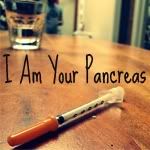Wednesday, July 7, 2010
Benign Transient Hyperphosphatasemia of infancy and early childhood . . .
9:12 PM
Ummm - yea - whatever that means! I'm seriously not that sure what it is but I am sure hoping that Nate has it!
Last week we took Nate to his endo for his quarterly appointment. At his new practice they do not do a finger stick HBA1C like they did at his previous practice. They do a full blown blood draw and run 'the works' to make sure everything is on track. Nate has not had his blood drawn since his diagnosis and even at that time we were never given any information on what tests were run or what the results were.
Type 1 diabetics run the risk of several other endocrine issues so I was thrilled to get a full work up and anxious to get the results back. Almost everything looks pretty good. His A1C is down an entire point, no thyroid problems, his cholesterol is good. A few issues --- his triglyceride results are high and his HDL is low which apparently is somewhat normal for T1 children. His alkaline phosphatase results came back extremely high and when I say HIGH --- I'm not even kidding. They should be somewhere between 200 - 400 and his came back at 3,017. What does this mean? I honestly just don't know - I've been on Dr. Google all day and I can't wrap my head around all of the things that it could mean but for now Nate's dr. is running more tests which should give us more answers soon.
And . . . if all of the the test results come back normal then they think he may have a case of Benign Transient Hyperphosphatasemia.
________________________________________
Here is the information that I was sent - It's a lot to digest so please feel free to bypass. :)
Transient hyperphosphatasemia (TH) of infancy and early childhood is characterized by a marked elevation of serum alkaline phosphatase in the absence of detectable liver or bone disease, and a return to normal levels within weeks or months. The condition is thought to be benign; thus, this disorder is also called benign transient hyperphosphatasemia. Recognition of this phenomenon permits avoidance of unnecessary procedures and concerns, provided that underlying liver and bone disease are appropriately excluded.
The clinical presentation and evaluation of an infant or young child with marked elevation of serum alkaline phosphatase will be reviewed here. Evaluation of an older child or adult with elevated alkaline phosphatase, or of any individual with elevations of multiple liver enzymes, is discussed separately. (See "Alkaline phosphatase and other enzymatic measures of cholestasis" and "Approach to the patient with abnormal liver function tests".)
The prevalence of TH is not known. In a series of 260 healthy infants, three (1.5 percent) had unexplained and transient elevations in serum AP, all more than three times the upper limit of normal for the assay [14]. Similar prevalence rates were seen in a separate study in which serum alkaline phosphatase levels >1000 U/L (2.5 times the upper limit of normal) were found in 2.8 percent of healthy children under two years of age. More moderate elevations of alkaline phosphatase, between 400 and 1000 U/L, were found in 5.1 percent of the subjects [15].
Most children with TH are healthy, although TH has occurred in association with a variety of clinical conditions, including gastroenteritis, respiratory infection, failure to thrive, and asthma. TH has also been reported with viral infections such as respiratory syncytial virus [16-18], enteroviruses [19], and HIV [20]; following liver [21,22] or kidney transplant [21]; and in children receiving chemotherapy for leukemia and lymphoma [11,23]. Some of these apparent disease associations may reflect more frequent laboratory testing to monitor the underlying disease. Indeed, in the largest study that prospectively evaluated a healthy population of infants and toddlers, no association with growth parameters was found [15]. A seasonal distribution of cases has been noted in some series, with more cases identified in late summer and early fall [5,11].
Measurement of alkaline phosphatase isoenzymes by electrophoresis can be helpful if this test is available. The presence of excessive bone and liver fractions supports the diagnosis of TH and argues against primary hepatic or bone disease. (See "Alkaline phosphatase and other enzymatic measures of cholestasis".)
The possibility of rickets should be raised by low serum levels of 25-hydroxyvitamin D with low serum calcium and/or phosphorus, elevated levels of PTH, a history of risk factors for vitamin D deficiency (exclusive breast feeding without vitamin D supplementation), or typical skeletal abnormalities. Any of these findings should prompt further evaluation for rickets, with radiographs of long bones. (See "Overview of rickets in children".)
Bone pain or other bone abnormalities should be evaluated radiographically for evidence of tumor, fracture, or juvenile Paget disease (a rare autosomal recessive disorder of bone turnover associated with bone deformities and susceptibility to fracture). Limb pain also can be caused by a variety of orthopedic, infectious, rheumatic, and neoplastic disorders, as discussed separately. (See "Clinical manifestations and diagnosis of Paget disease of bone" and "Clinical assessment of the child with suspected cancer", section on 'Bone and joint pain' and "Overview of the causes of limp in children".)
Last week we took Nate to his endo for his quarterly appointment. At his new practice they do not do a finger stick HBA1C like they did at his previous practice. They do a full blown blood draw and run 'the works' to make sure everything is on track. Nate has not had his blood drawn since his diagnosis and even at that time we were never given any information on what tests were run or what the results were.
Type 1 diabetics run the risk of several other endocrine issues so I was thrilled to get a full work up and anxious to get the results back. Almost everything looks pretty good. His A1C is down an entire point, no thyroid problems, his cholesterol is good. A few issues --- his triglyceride results are high and his HDL is low which apparently is somewhat normal for T1 children. His alkaline phosphatase results came back extremely high and when I say HIGH --- I'm not even kidding. They should be somewhere between 200 - 400 and his came back at 3,017. What does this mean? I honestly just don't know - I've been on Dr. Google all day and I can't wrap my head around all of the things that it could mean but for now Nate's dr. is running more tests which should give us more answers soon.
And . . . if all of the the test results come back normal then they think he may have a case of Benign Transient Hyperphosphatasemia.
________________________________________
Here is the information that I was sent - It's a lot to digest so please feel free to bypass. :)
Transient hyperphosphatasemia (TH) of infancy and early childhood is characterized by a marked elevation of serum alkaline phosphatase in the absence of detectable liver or bone disease, and a return to normal levels within weeks or months. The condition is thought to be benign; thus, this disorder is also called benign transient hyperphosphatasemia. Recognition of this phenomenon permits avoidance of unnecessary procedures and concerns, provided that underlying liver and bone disease are appropriately excluded.
The clinical presentation and evaluation of an infant or young child with marked elevation of serum alkaline phosphatase will be reviewed here. Evaluation of an older child or adult with elevated alkaline phosphatase, or of any individual with elevations of multiple liver enzymes, is discussed separately. (See "Alkaline phosphatase and other enzymatic measures of cholestasis" and "Approach to the patient with abnormal liver function tests".)
CLINICAL PRESENTATION — TH occurs most commonly in infants and children younger than five years of age. A few adults with similar patterns have been reported [1-4]. The serum alkaline phosphatase (AP) is typically elevated four to five times the upper limit of normal, but elevations up to 20 times the pediatric upper reference limit (or 50 times the adult upper reference limit) have been described [5-7]. In most cases there are elevations in both liver and bone isoenzymes, and (rarely) in intestinal isoenzymes [5,8].
Serum AP levels gradually return to normal within two to three months but have persisted as long as six months in a few cases [9,10]. The half-life of AP ranges from 5 to 25 days, depending upon coexisting morbidities [11]. In series reporting the results of long-term follow-up, no clinical sequelae were noted up to four years after the episode of TH [12,13].The prevalence of TH is not known. In a series of 260 healthy infants, three (1.5 percent) had unexplained and transient elevations in serum AP, all more than three times the upper limit of normal for the assay [14]. Similar prevalence rates were seen in a separate study in which serum alkaline phosphatase levels >1000 U/L (2.5 times the upper limit of normal) were found in 2.8 percent of healthy children under two years of age. More moderate elevations of alkaline phosphatase, between 400 and 1000 U/L, were found in 5.1 percent of the subjects [15].
Most children with TH are healthy, although TH has occurred in association with a variety of clinical conditions, including gastroenteritis, respiratory infection, failure to thrive, and asthma. TH has also been reported with viral infections such as respiratory syncytial virus [16-18], enteroviruses [19], and HIV [20]; following liver [21,22] or kidney transplant [21]; and in children receiving chemotherapy for leukemia and lymphoma [11,23]. Some of these apparent disease associations may reflect more frequent laboratory testing to monitor the underlying disease. Indeed, in the largest study that prospectively evaluated a healthy population of infants and toddlers, no association with growth parameters was found [15]. A seasonal distribution of cases has been noted in some series, with more cases identified in late summer and early fall [5,11].
NORMAL RANGES FOR SERUM AP — Serum alkaline phosphatase (AP) activities are generally higher in children than in adults because of physiologically higher rates of osteoblastic activity. In infants, activities are approximately three times the upper reference limit for adults, peaking between one and six months of age [6]. By two years of age, serum AP levels fall to approximately twice the upper reference limit for adults (graph 1). A second peak occurs in early puberty for girls (around 12 years) and mid-puberty for boys (around 14 years), coinciding with maximum growth velocity. (See "The child with tall stature or abnormally rapid growth", section on 'Growth velocity'.)
PATHOGENESIS — The pathogenesis of TH is not well understood, as both liver and bone isoenzymes are usually increased. Several investigators have demonstrated that a fraction of both isoenzymes has a characteristic increase in electrophoretic mobility, due to increased content of sialic acid [6,11]. This observation has led to the hypothesis that the hyperphosphatasemia is caused by excessive sialylation of alkaline phosphatase (AP), which slows clearance of the isoenzymes.
The cause of the increased sialylation remains uncertain. By definition, TH is not caused by vitamin D deficiency. However, one hypothesis is that TH develops because there is increased production of AP during a period of catch-up growth after weight loss or vitamin D insufficiency, at a rate that overwhelms the mechanisms that normally desialylate the enzyme [11]. If so, children with TH might display subclinical vitamin D insufficiency at the time of diagnosis. However, this was not the case in one series of healthy infants and children, in which there was no difference in serum levels of vitamin D, parathyroid hormone, calcium, or phosphorus among subjects with TH as compared to those with normal AP levels [15].EVALUATION AND MANAGEMENT — Awareness of the entity of TH can avoid unnecessary tests in infants and children with this disorder. A careful history, physical examination, and abbreviated laboratory evaluation are usually sufficient to rule out other causes of the elevated alkaline phosphatase (AP).
History — The clinician should inquire about bone disease (unexplained fractures, family history of bone disease, or complaints of bone pain); symptoms suggestive of liver disease (right upper quadrant pain, pruritus, steatorrhea, or dark-colored urine); drugs; renal disease; and nonspecific symptoms including anorexia, weight loss, fever, and lethargy.
Risk factors for nutritional rickets should be assessed, including exclusive breast feeding or intake of less than one liter of vitamin D-fortified formula or milk daily, dark skin pigmentation, low exposure to sunlight, or prematurity. These infants and children are at risk for rickets unless given vitamin D supplements of at least 400 IU daily. (See "Overview of rickets in children".)Physical examination — The patient should be examined for deformities, tenderness, or other abnormalities of bone, including skeletal abnormalities associated with rickets (beading at the costochondral junction or bowing of long bones) and bone tenderness. The examination should also include assessment for hepatomegaly, splenomegaly, liver tenderness, scleral icterus, jaundice, and stigmata of chronic liver disease (palmar erythema, spider telangiectasia, clubbing, caput medusae).
Laboratory testing — Initial laboratory testing should include serum aspartate aminotransferase, alanine aminotransferase, bilirubin, calcium, phosphorus, 25-hydroxyvitamin D (calcidiol), parathyroid hormone (PTH), blood urea nitrogen, and creatinine. Either gamma-glutamyl transpeptidase (GGT) or 5'-nucleotidase should also be measured to further exclude liver disease.
A normal result for each of these tests is adequate to establish a provisional diagnosis of TH in an otherwise healthy infant or young child. Of note, the serum GGT activity is six to seven times the upper limit of the adult reference range in normal full-term neonates; levels decline and reach adult levels by five to seven months of age [24].Measurement of alkaline phosphatase isoenzymes by electrophoresis can be helpful if this test is available. The presence of excessive bone and liver fractions supports the diagnosis of TH and argues against primary hepatic or bone disease. (See "Alkaline phosphatase and other enzymatic measures of cholestasis".)
The possibility of rickets should be raised by low serum levels of 25-hydroxyvitamin D with low serum calcium and/or phosphorus, elevated levels of PTH, a history of risk factors for vitamin D deficiency (exclusive breast feeding without vitamin D supplementation), or typical skeletal abnormalities. Any of these findings should prompt further evaluation for rickets, with radiographs of long bones. (See "Overview of rickets in children".)
Bone pain or other bone abnormalities should be evaluated radiographically for evidence of tumor, fracture, or juvenile Paget disease (a rare autosomal recessive disorder of bone turnover associated with bone deformities and susceptibility to fracture). Limb pain also can be caused by a variety of orthopedic, infectious, rheumatic, and neoplastic disorders, as discussed separately. (See "Clinical manifestations and diagnosis of Paget disease of bone" and "Clinical assessment of the child with suspected cancer", section on 'Bone and joint pain' and "Overview of the causes of limp in children".)
Monitoring — Children with vitamin D deficient rickets should be treated with replacement doses of vitamin D (ergocalciferol). All other children should be evaluated to ensure adequate intake of vitamin D and supplemented with at least 400 IU daily if needed; steps should also be taken to ensure adequate intake of calcium. (See "Etiology and treatment of hypocalcemic rickets in children" and "Overview of vitamin D".)
Follow-up to document return of serum alkaline phosphatase (AP) levels to normal is critical for confirmation of the diagnosis of TH [25]. In our practice, we repeat serum AP measurement in a child with the provisional diagnosis of TH within two weeks, and then monthly until a downward trend is noted and normal values are attained. Sustained serum AP elevation beyond three to four months should prompt reconsideration of other causes of hyperphosphatasemia, including the bone disorders mentioned in the preceding section.SUMMARY AND RECOMMENDATIONS
- Transient hyperphosphatasemia (TH) of infancy and early childhood is characterized by a marked elevation of serum alkaline phosphatase (AP) in the absence of detectable liver or bone disease. Almost all cases occur in infants and children younger than five years of age. (See 'Clinical presentation' above.)
- In TH, the serum AP is typically elevated four to five times the upper limit of the pediatric reference range, and gradually returns to normal within two to three months. (See 'Clinical presentation' above.)
- Serum AP activities are higher in children than in adults because of physiological osteoblastic activity. The upper limit of the pediatric reference range is up to three times higher than in adults, peaking in late infancy and again during puberty (graph 1). (See 'Normal ranges for serum AP' above.)
- TH is characterized by elevations in both bone and liver alkaline phosphatase isoenzymes. The pathogenesis has not been fully established, but is thought to include reduced clearance of AP due to increased sialic acid content, perhaps caused by or compounded by a transient surge in alkaline phosphatase production. (See 'Pathogenesis' above.)
- The evaluation should include a history and physical examination to assess for evidence of primary liver or bone disease. Laboratory testing should include measurement of serum aspartate aminotransferase, alanine aminotransferase, bilirubin, calcium, phosphorus, 25-hydroxyvitamin D, parathyroid hormone, blood urea nitrogen, and creatinine. In addition, measurement of either gamma-glutamyl transpeptidase (GGT) or 5'-nucleotidase helps to exclude liver disease. (See 'Evaluation and management' above.)
- The possibility of rickets should be raised by low serum levels of 25-hydroxyvitamin D, calcium or phosphorus, elevated serum parathyroid hormone, a history of risk factors for vitamin D deficiency such as exclusive breast feeding without vitamin D supplementation, or typical skeletal abnormalities. Any of these findings should prompt further evaluation, including radiographs of long bones. (See 'Laboratory testing' above and "Overview of rickets in children".)
- Even if rickets is excluded, all children should be evaluated to ensure adequate intake of vitamin D and supplemented with at least 400 IU daily if needed. Steps should also be taken to ensure adequate intake of calcium. (See 'Monitoring' above.)
- If there is no evidence of liver or bone disease in an infant or young child, then the provisional diagnosis of TH can be made. Repeat measurement of serum AP should be performed at intervals until normal values are attained. (See 'Monitoring' above.)
Use of UpToDate is subject to the Subscription and License Agreement.
REFERENCES
Subscribe to:
Post Comments
(Atom)

Just a Mom
I am NOT a doctor, nor do I play one on this blog.
I AM a wife.
I AM the mom of 3 wonderful children.
I AM my son's pancreas.
The information provided on this blog is from our personal experiences with Type 1 diabetes. Because something works for us does not mean it will work for you.
Please consult your doctor if you have any questions or concerns about your health care options.
I AM a wife.
I AM the mom of 3 wonderful children.
I AM my son's pancreas.
The information provided on this blog is from our personal experiences with Type 1 diabetes. Because something works for us does not mean it will work for you.
Please consult your doctor if you have any questions or concerns about your health care options.
Powered by Blogger.
Grab my button!




Check out these AWESOME
D-rent Blogs . . .
D-rent Blogs . . .
Followers
Blog Archive
-
▼
2010
(136)
-
▼
July
(16)
- D-Feast Friday --- A Review
- A picture is worth 1000 words . . .
- As promised . . .
- Why I Still Cry . . .
- JDRF Car Magnets
- D-Feast Friday
- Dear Insurance Companies,
- More swimmers in the family . . .
- Beep Beep Beep Beep Beep
- I have another child . . . Really I do!!
- Rockin' the bg check at 2 years old -
- Another new kind of fine . . .
- The Cost Of It All . . .
- Official DX = Benign Transient Hyperphosphatasemia
- Benign Transient Hyperphosphatasemia of infancy an...
- Apidra - More by Popular Demand!
-
▼
July
(16)

My Blog List
-
-
Employment Anxiety Abound5 weeks ago
-
-
-
Winter Solstice1 year ago
-
-
Post-Pod Supper5 years ago
-
-
-
-
Coexisting with dark places.6 years ago
-
Pod Hockey6 years ago
-
-
-
The Mirror7 years ago
-
Jon Obst - RIP8 years ago
-
-
Stars Aligned….8 years ago
-
For the Newly Diagnosed...8 years ago
-
Happy Easter 20169 years ago
-
-
-
Hope10 years ago
-
10 Years Ago Today10 years ago
-
UPDATES UPDATES UPDATES10 years ago
-
Lucas-isms10 years ago
-
-
-
Diabetes Resolutions10 years ago
-
T-Slim - I'm beginning to love you...11 years ago
-
-
Worry...Worry...WORRY!11 years ago
-
I NEED The Arrows!!11 years ago
-
Anyone have ink?11 years ago
-
-
-
Goodbye Sweet Friend12 years ago
-
For You, My Friend12 years ago
-
-
For Shamae12 years ago
-
Karen Jensen, RD12 years ago
-
Callan12 years ago
-
-
3 Years12 years ago
-
Email Subscriptions.12 years ago
-
Growing up and letting go12 years ago
-
Bye Bye Insulet, Hello Medtronic12 years ago
-
-
Hope on 2 Wheels Documentary13 years ago
-
-
Cross Talk Radio Show Link :)13 years ago
-
Back to School - Our Lunch Time Dilemma13 years ago
-
-
How To Manage Your Stockpile13 years ago
-
Russian Custard13 years ago
-
Diabetes Tourettes13 years ago
-
A story13 years ago
-
10 years13 years ago
-
Were Off to see the Wizard13 years ago
-
I’m Just Not That Into This.13 years ago
-
CBS 5... Shame On You!14 years ago
-
JDRF Walk to Cure Diabetes14 years ago
-
totally random14 years ago
-
I think I can breath again14 years ago
-
-
Weekend Meme14 years ago
-
Think positive...14 years ago
-
Lipoatrophy14 years ago
-
-
-
"What I Am"15 years ago
-
-
Missing.....15 years ago
-
I'm BACK!15 years ago
-
-
SleepOVERS!!!15 years ago
-
-
-
-
-
-
-
-
-
-
-
-
-
-
-
-
-
-
































12 comments:
(1) Really? A finger prick? Dr Miklius ALWAYS does a full workup. I love it. So glad you are happy there.
(2) Hope the transient whatever is definitely transient and all is well!
(3) We need a playdate - with or without kids.
That's a lot of info to digest. Does your brain hurt yet? Good luck with the diagnosis. I assume you have to wait a couple months to see if the numbers go down on their own. If that's the case I'm sending you all the patience I can spare. I wish you and Nate well.
If I know transient benign whatsathingy...this is it! This is so it! He'll be back to the good ol 2-4 hundreds soon...I just know it! Prayers for you friend!!
PS: Dear Lord, Please give Laura a break. No more drama for the momma! Thanks, Meri
LOL @ Jessica's comment...You need a break from "medical drama" girly!!!
Wow Dr. Laura. Oh my. I hope things return to normal soon for you and for Nate. Please keep us posted. When are you getting your MD license???
I'm with the others. You deserve a break! I hope this really is transient and resolves itself soon!!!
Your kids are so blessed to have you as their mommy. I pray everything comes back A-OK!
Prayers for normalcy.
Your kids are so blessed to have you as a mommy. Make sure to take a bit of time to do some fun, not serious g time for yourself.
xoxox
Good Hell, woman! I can't even pronounce half that stuff! Here's to a lower A1c and all the other good stuff! Let me know what you find out! Love you!
Hi my 19 month old has had a rash that my MD believes to be GCS, Gianotti Crosti Syndrome from an unknown cause and while having bloodwork done last week to check her lab values and platelet count bc of suspected petechiae, her ALP came back 4799, we went to MD today and had it rechecked to make sure not lab error and it was 4024. So the MD is consulting some other physicians to see what to do next. I think this may be it. All her other lab work is normal, nothing pointing to bone or liver disorders, bilirubin ast and alt are normal and calcium is normal and she gets plenty of vit d so no rickets. Other than the recent viral infection she has had no other complaints. hopefully this is all it is. Thank you so much for sharing this educated and wel documented information.
SgaMommy
My daughter is 12 months and I was doing research on elevations of alkaline phosphatase because she recently had a blood test and her alkaline phosphatase level was actually over 7,000! Needless to say, her pediatrician was pretty shocked and suggested that we run additional bloodwork. I was wondering how you made out with this and whether your son was diagnosed w/ TH. We are still ruling out other issues. She had more blood drawn today (4 vials) and they are going to isolate the alkaline phosphatase to determine if it is due to bone or liver issues, rule out vitamin D deficiency and check her other vitamin levels in her body. Keeping my fingers crossed that it is either TH or some other seemingly innocuous thing.
Marguerite, It was TH and we just had him retested last week and AP is back in range for a growing boy.
We did do another blood draw and everything else was completely normal so no further testing was done at that time. We knew we would re-check him in 3-months and go from there.
I actually just posted his results today.
http://www.houstonwehaveaproblemblog.com/2010/09/freaking-out-little-a1c-open-and-honest.html
Feel free to email me at houstonwehaveaproblemblog@gmail.com
:)